Ingredient innovation
Overview
Native and emulsified milk fat globule size is considered a pivotal processing and functionality parameter in many fat-structured dairy products. This project aims to manipulate different sized milk fat globules (MFG) to achieve better physical functionality of fat components in selected high-fat dairy products, eg. cream, butter and spreads (Figure 1). This includes both fundamental and application studies along with pilot scale trials, aiming to provide controllable and scalable techniques that can be translated to the dairy industry.
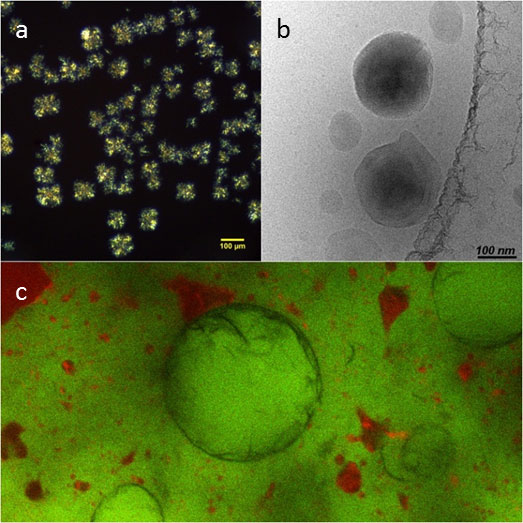
A technique, known as microfluidization, has been used to reduce MFG s to submicron- and nano-sized proportions. A two-stage separation method has been developed to fractionate native milk and cream on the basis of fat globule size. These size differentiated milk streams and creams will be used to manufacture butter, fat-reduced dairy spreads, low-fat cream and cream powders. An innovative approach using dissolved CO2 in milk fat to modify milk fat crystallisation has also been evaluated and applied to butter making. The findings on different sized MFG s will assist the development of innovative dairy products. A two-stage separation method and the utilisation of CO2-enhanced crystallisation can be used as additional tools to control or modify manufacturing processes (Figure 2).

Capabilities and technologies
Microfluidization
Formation of small droplets at the submicron- to nano-scale requires large amounts of surfactant and/or mechanical energy (microfluidization). Microfluidization is a process that utilises intensively disruptive forces created by the collision of two rapidly flowing streams in an interaction chamber. Nano-sized creams (< 200 nm) have been prepared using this method.
Two-stage fractionation of dairy cream
A novel two-stage separation method has been developed to fractionate milk/cream on the basis of mean MFG size. The first stage involves a unique centrifugal separation technique, where two streams of milk, one rich in large fat globules and another rich in small fat globules, are obtained by fractionation in a modified cream separator. In the second stage, the two streams from the first stage are each further fractionated in a conventional cream separator.
CO2-enhanced crystallisation
The crystallisation of solid foods (fats/oils, lactose, water) can be influenced by dissolving or non-dissolving entities present in the food matrix. Carbon dioxide is a hydrophobic gas that is soluble in lipids and water. This gas is used in the modified atmospheric packaging of fruits, vegetables, drinks, meat and cheese. The gas is non-toxic and environmentally safe. Being a soluble gas in a food system, it can take part in the crystallisation process, in turn, affecting product properties. We have developed methods to dissolve CO2 into anhydrous milk fat (AMF) at various scales (Figure 3).
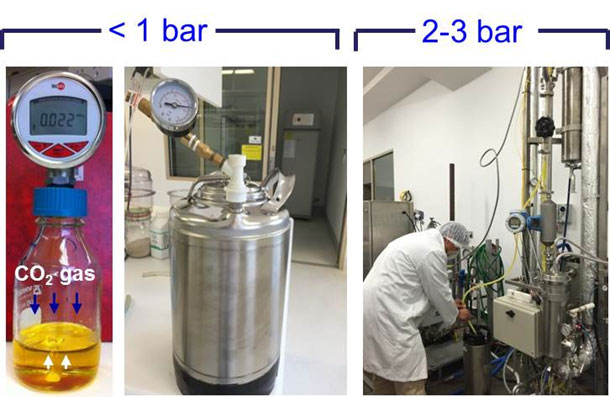
Characterisation techniques
Our core analysis capabilities include differential scanning calorimetry (DSC), small angle X-ray scattering/wide angle X-ray scattering (SAXS/WAXS), texture analysis, electron microscopy, confocal laser scanning microscopy (CLSM), rheology, tribology, and solid-phase microextraction gas chromatography-mass spectrometry (SPME GC-MS). The facilities support both the Ingredient Innovation team and other Hub members through collaborative research arrangements and can also be accessed as fee-for-service.
Outcomes
Butter has been manufactured from nano-sized cream (< 200 nm) using a temperature-controlled Stephan mixer (Figure 4).
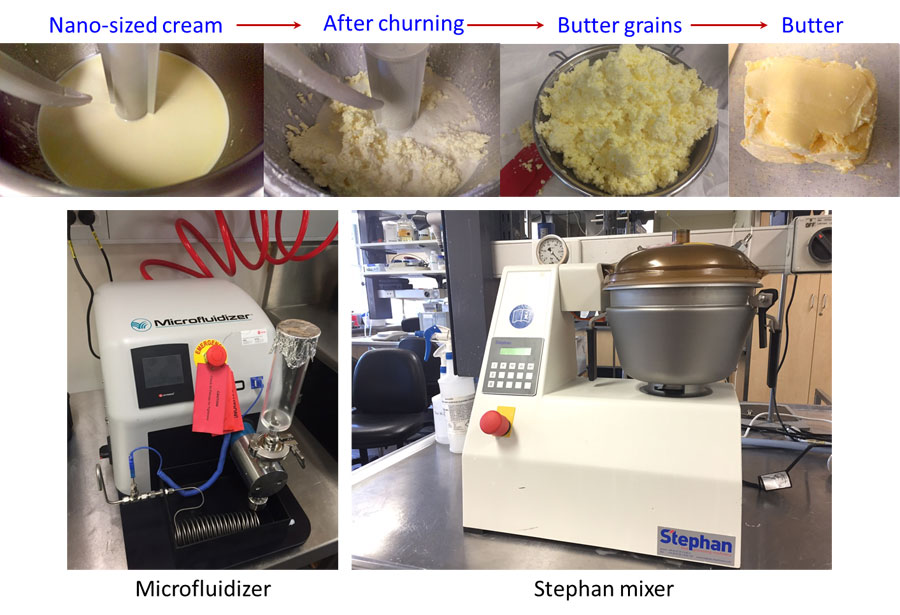
A two-stage separation process has been developed that can create streams with a mean fat globule size (D [4,3]) as small as 1.35 µm and as large as 4.28 µm without affecting droplet integrity (Figure 5). With further development, given its high throughput, good separation efficiency and use of conventional processing equipment, this method could provide the basis for a new industrial process to generate fractionated milk streams and creams with contrasting physical functionality and nutritional value, based on MFG size.
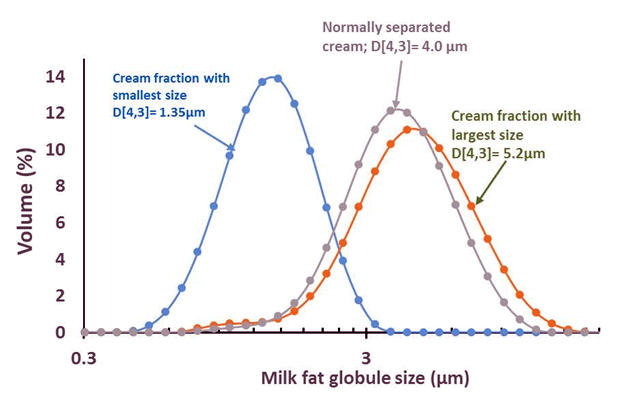
We have demonstrated that dissolved CO2 can be used to modulate the crystallisation behaviour, microstructure and texture of anhydrous milk fat (AMF). The addition of CO2 has been shown to enhance crystallinity, accelerate crystal nucleation and induce a larger number of smaller crystals than observed in untreated AMF. When applying this technique to butter making, we found that carbonation (0–2000 ppm) of warm cream (35°C) can be used to reduce the churning time of the butter making process. Carbonation did not show any adverse effect on colour, microstructure (Figure 6) and sensory quality of the resultant butter.
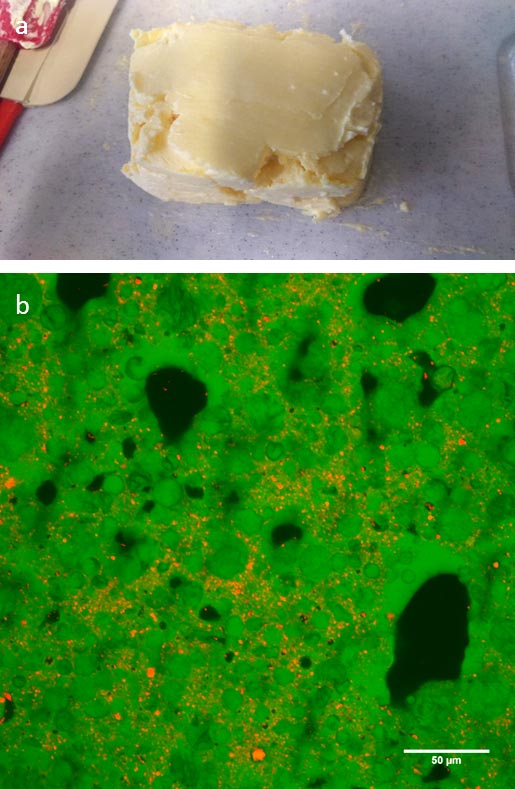
Publications
2020
Truong, T. & Bhandari, B. (2020) Book chapter - Role of differentiated-size milk fat globules on the physical functionality of diary-fat structured products. In: Truong, T., Lopez, C., Prakash, S. & Bhandari, B. (Eds.) Dairy Fat Products and Functionality: Fundamental Science and Technology, (pp. 327–354), Springer, ISBN 978-3-030-41661-4.
Dhungana, P. & Bhandari, B. (2020) Book chapter - Dairy creams and related products. In: Truong, T., Lopez, C., Prakash, S. & Bhandari, B. (Eds.) Dairy Fat Products and Functionality: Fundamental Science and Technology, (pp. 431–452), Springer, ISBN 978-3-030-41661-4.
Panchal, B. & Bhandari, B. (2020) Book chapter - Butter and dairy fat spreads. In: Truong, T., Lopez, C., Prakash, S. & Bhandari, B. (Eds.) Dairy Fat Products and Functionality: Fundamental Science and Technology, (pp. 509–532), Springer, ISBN 978-3-030-41661-4.
Dhungana, P., Truong, T., Bansal, N. & Bhandari, B. (2020) Effect of fat globule size on the physicochemical properties of dairy cream powder produced by spray drying. Drying Technology, 1-13. https://doi.org/10.1080/07373937.2020.1758129.
Dhungana, P., Truong, T., Bansal, N. & Bhandari, B. (2020) Effect of fat globule size and addition of surfactants on whippability of native and homogenised dairy creams. International Dairy Journal. https://doi.org/10.1016/j.idairyj.2020.104671.
2019
Truong, T., Palmer, M., Bansal, N. & Bhandari, B. (2019) Effect of dissolved carbon dioxide on the sonocrystallisation and physical properties of anhydrous milk fat. International Dairy Journal, 93, 45-56. https://doi.org/10.1016/j.idairyj.2019.02.001.
Dhungana, P., Truong, T., Bansal, N. & Bhandari, B. (2019) Apparent thermal and UHT stability of native, homogenized and recombined creams with different average fat globule sizes. Food Research International, 123, 153–165. https://doi.org/10.1016/j.foodres.2019.04.054.
2018
Truong, T., Palmer, M., Bansal, N. & Bhandari, B. (2018) Effects of dissolved carbon dioxide in fat phase of cream on manufacturing and physical properties of butter. Journal of Food Engineering, 226, 9–21. https://doi.org/10.1016/j.jfoodeng.2018.01.012.
2017
Panchal, B. R., Truong, T., Prakash, S., Bansal, N. & Bhandari, B. (2017) Effect of fat globule size on the churnability of dairy cream. Food Research International, 99, 229-238. https://doi.org/10.1016/j.foodres.2017.05.027.
Truong, T., Palmer, M., Bansal, N. & Bhandari, B. (2017) Effect of solubilised carbon dioxide at low partial pressure on crystallisation behaviour, microstructure and texture of anhydrous milk fat. Food Research International, 95, 82–90. https://doi.org/10.1016/j.foodres.2017.02.022.
Truong, T., Palmer, M., Bansal, N. & Bhandari, B. (2017) Investigation of solubility of carbon dioxide in anhydrous milk fat by lab-scale manometric method. Food Chemistry, 237, 667-676. https://doi.org/10.1016/j.foodchem.2017.05.141.
Dhungana, P., Truong, T., Palmer, M., Bansal, N. & Bhandari, B. (2017) Size-based fractionation of native milk fat globules by two-stage centrifugal separation. Innovative Food Science & Emerging Technologies, 41, 235–243. https://doi.org/10.1016/j.ifset.2017.03.011.
Hussain, H., Truong, T., Bansal, N. & Bhandari, B. (2017) The effect of manipulating fat globule size on the stability and rheological properties of dairy creams. Food Biophysics, 12 (1), 1-10. https://doi.org/10.1007/s11483-016-9457-0.
2016
Truong, T., Palmer, M., Bansal, N. & Bhandari, B. (2016) Effect of Milk Fat Globule Size on the Physical Functionality of Dairy Products. Cham, Switzerland: Springer International Publishing. https://doi.org/10.1007/978-3-319-23877-7.
2015
Truong, T., Morgan, G. P., Bansal, N., Palmer, M. & Bhandari, B. (2015) Crystal structures and morphologies of fractionated milk fat in nanoemulsions. Food Chemistry, 171, 157–167. https://doi.org/10.1016/j.foodchem.2014.08.113.